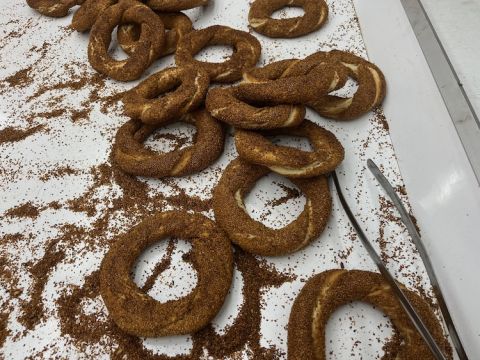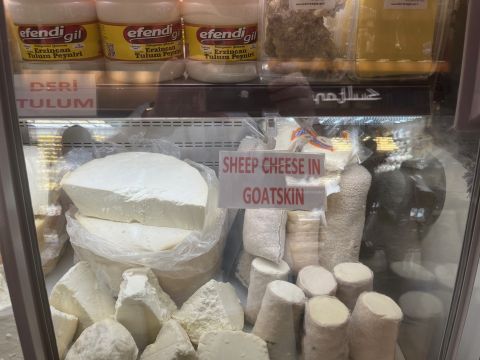A food tour of Istanbul

The Mecca of street food where Europe meets Asia.
One of the few disadvantages, and perhaps it is the only one, of writing this column is that it demands either lunch or dinner in a restaurant, which tends to rule out the possibility of enjoying street food. A restaurant meal consists of at least a couple of courses, usually but not always sitting indoors – a way of living which clashes somewhat with the more relaxed pleasure of a series of snacks eaten with your hands while walking the streets in the sunshine.
Four hours in the company of Gamze Ineceli one sunny Sunday in Istanbul in many ways confirmed this disadvantage for it could not have been more pleasurable.
I put myself entirely in Ineceli’s experienced hands. A long-standing food writer who is a trustee of the Oxford Food Symposium, she is currently working with Elizabeth Luard on a book that traces the history of Anatolia through its many and varied foods. More pertinently, she is Istanbul-born and has lived through an era when successive waves of immigrants from the east have brought with them many new and different types of street food.
‘When I grew up, I had no idea what a kebab was’, Ineceli told me. ‘They did not exist in Istanbul. Today, they are synonymous with my city and my country. But the range of street food is changing again with the many who have moved here as the situations in Syria, Palestine, Afghanistan and Iraq, as well as Ukraine, deteriorate, settling and serving their style of increasingly spicy street food to keep themselves alive. Street food is the migration history of Istanbul. It is precisely this rich mosaic which makes it the major world city it is.’
The city has indeed become the Mecca of street food. The sunny weather plays a significant role in this development, as do the narrow streets which seem to trap all the aromas from their vast number of roadside grills. Certainly the narrow Kemeralti Avenue smelled very different at 4.30 pm when I walked down it for the second time than it had at 11 am when we wandered there first.
But possibly even more important than its social history is its geography. Istanbul is one of few cities in the world split by seawater, as opposed to the rivers that flow through so many other cities. As a result, many Istanbul residents travel by the inexpensive boats which, together with sea air, can certainly stimulate an appetite, and there are plenty of landing stops for the vendors, and numerous bridges and open spaces where citizens gather.
We met at 10.45 am in Karaköy and naturally we headed for a coffee. Our first destination was the Karabatak (cormorant) Café pictured above, which has everything an Istanbul cafe requires: excellent Turkish coffee, outdoor seating, and it faces an old wall (here you are never too far from a mosque, church or synagogue). The coffee is as good as it had been at breakfast at the newish Peninsula Hotel, which has the great advantage of being right on the Bosphorus.
We reluctantly passed a cafe offering ‘fish wraps’ of grilled mackerel and walked into a bakery. I watched as Ineceli interrogated a favourite baker and we saw a tray of sesame-coated simits, the prized giant, soft pretzel-like local speciality, as his assistant thoughtfully opened the deep oven which had just produced them. We bought two in Istanbul tradition: one for us to eat and the other to throw to the seagulls, the bird of this city, as we travelled across to Anatolia on the Asian side of this sprawling city.
But first my guide showed me the ingredients for a traditional Turkish breakfast. We made our way through the crowds (Istanbul is a very busy city) waiting outside for a table at Namlı Gurme restaurant and headed to the shop at the rear. There were mounds of food everywhere: meat, cheeses, baklava, assorted types of honey in myriad colours, and, in the far left-hand corner, an enormous offering of olives – black and green, stoned and not, stuffed and plain, grilled (as below) and not.
The boat trip from European Istanbul to the Asian side is fascinating and we arrived to find more crowds and the aromas of grilling sweetcorn, which has just come into season. In the winter months, these are substituted by chestnuts. We were soon in the narrow streets on this side of the Bosphorus, packed with food stores cheek by jowl which I remember from our first visit in 2009. The differences between the European and Asian sides seemed less pronounced this time.
I was led into a branch of Ali Muhiddin Hacı Bekir which has been making lokum (Turkish delight) and chocolates since the late 18th century. The shop reminds me of those I remember as a child: very personal, lots of staff and a huge display of every kind of sweetmeat imaginable. I was asked whether I like walnuts and before I had a chance to reply, Gamze was instructing a young man behind the counter to fill a box with walnuts wrapped in filo pastry. I then watched him carefully wrap the box with paper, twirling the ends of the ribbon with the utmost care before handing it over.
Such an encounter titillated my taste buds and before long we were walking past a branch of Ciya Sofrasi, the small group of Turkish restaurants established by chef Musa Dağdeviren, author of The Turkish Cookbook. We went in and, although it was only just after midday, the kitchen was full of the many different dishes from all over this enormous country which Dağdeviren has brought to a wider public. We each ordered baklava and I enjoyed for the first time a glass of sumac juice (see above), made from ground sumac and water, which went some way to quenching my enormous thirst.
We then took the ferry back to Europe (quite fun to write this, even more to do it in the sparkling sunshine), getting off at Eminönü with the prospect of visiting the Egyptian Market, a spice bazaar. This appeared to be a vast collection of small stores, many of them selling similar spices, cheeses and meat that seemed of high quality. We were heading for Cankurtaran Gida, where the main picture above was taken.
This long-established family business houses the proprietor at his desk at the far end, from which I took this photo. Both sides of his entrepot are lined with shelves from floor to ceiling laden with huge amounts of produce. Honey at the front; salamis and pastrami down the right-hand side; cheeses down the left; as well as olives and everything else one can think of to tempt Istanbulites to buy so as to eat and live well.
After a significant tasting of at least eight cheeses, I was taken to the front vitrine where there is the physical shape of a goat skin underneath a sign that reads ‘Sheep cheese in goat skin’ which Gamze explained as follows: ‘This was produced in Anatolia by nomads on the move. They would produce the cheese and leave it in caves until their return. But they had very limited resources and the sheep produced wool that was too valuable to use for storing the cheese so they used what was available, which was the goatskin. It produces the most amazing cheese with a red colour from the skin.’ The aroma was certainly strong, but not offensive.
We walked back to the Karaköy suburb across the Galata Bridge. I had had such an enjoyable day, with such varied types of street food, that I was even able to resist the charms of grilled fish at Güleryüz Balıkçısı, right by the water’s edge.
Karabatak Kemankeş Karamustafa Paşa, Karaali Kaptan Sk. No 7, 34425 Beyoğlu, İstanbul, Türkiye; tel: +90 (0212) 243 6995
Namli Gurme Kemankeş Karamustafa Paşa Mahallesi, Mumhane Cad. Atilla İş Hanı No 6/A İstanbul, Türkiye; tel: +90 (0212) 293 6880
Ali Muhiddin Hacı Bekir Hobyar, 1, Zahire Borsası Sk., 34112 Fatih, İstanbul, Türkiye; tel: +90 (0212) 522 0666
Çiya Sofrasi Caferağa, Güneşli Bahçe Sok, 34710 Kadıköy, İstanbul, Türkiye; tel: +90 (0216) 418 5115
Cankurtaran Gida Mısır Çarşısı İçi No 33, 34116 Fatih, İstanbul, Türkiye; tel: +90 (0212) 527 1474
Every Sunday, Nick writes about restaurants. To stay abreast of his reviews, sign up for our weekly newsletter.
Become a member to view this article and thousands more!
- 15,416 featured articles
- 275,321 wine reviews
- Maps from The World Atlas of Wine, 8th edition (RRP £50)
- The Oxford Companion to Wine, 5th edition (RRP £50)
- Members’ forum
- 15,416 featured articles
- 275,321 wine reviews
- Maps from The World Atlas of Wine, 8th edition (RRP £50)
- The Oxford Companion to Wine, 5th edition (RRP £50)
- Members’ forum
- 48-hour preview of all scheduled articles
- Commercial use of our wine reviews






